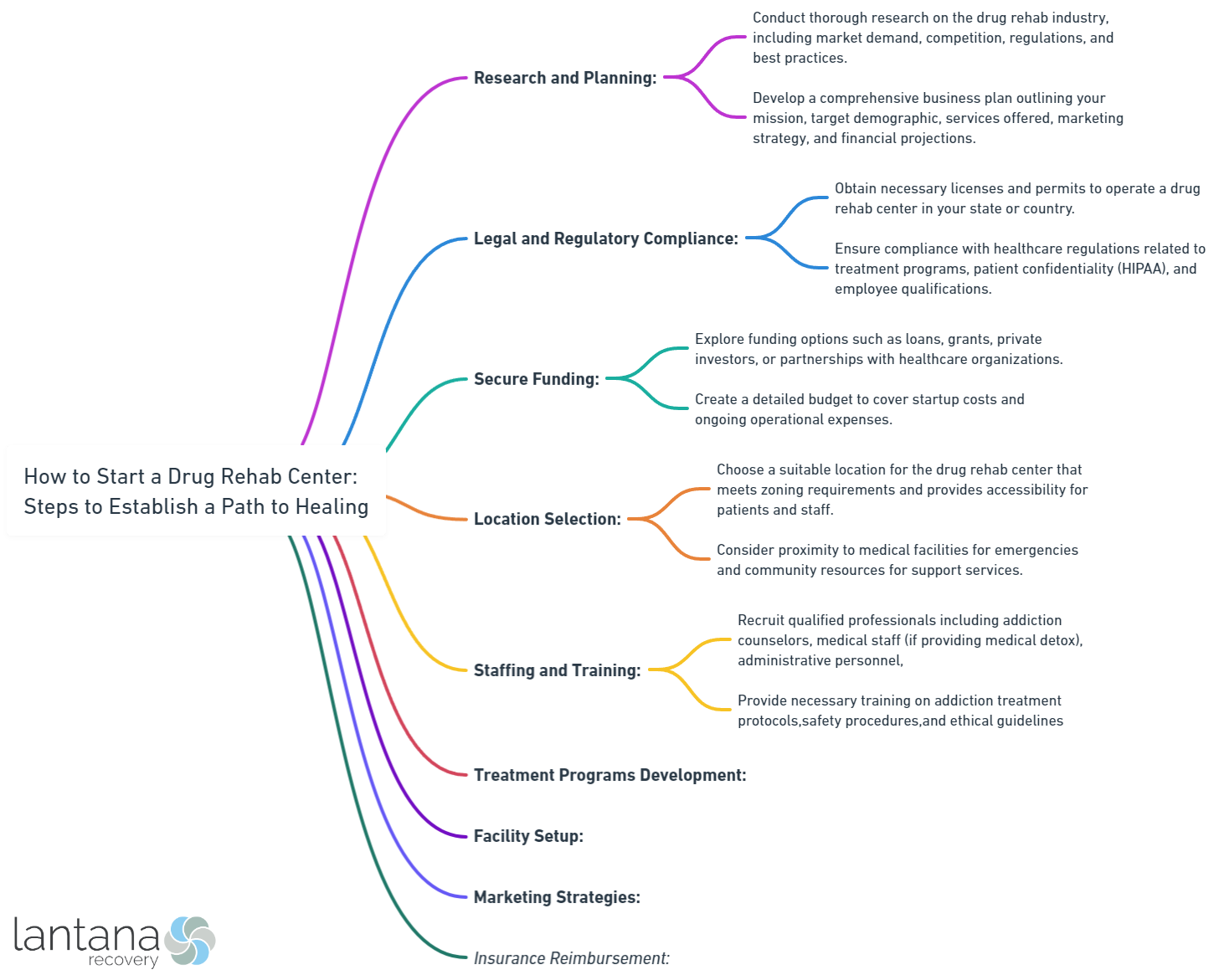Starting a drug rehab center is a noble and crucial endeavor that requires careful planning and strategic steps. Understanding the need for such a facility sets the foundation for creating a path to healing for individuals struggling with substance abuse. Current substance abuse statistics highlight the urgent need for effective treatment options, making drug rehab centers necessary in providing comprehensive and specialized care.
Before diving into the process of establishing a drug rehab center, it is vital to identify your goals and objectives. Consider the specific mission and vision you have for the center, as well as the target population and treatment approach you aim to provide. Thorough research and planning are necessary to ensure the success and effectiveness of your facility.
As part of your research and planning phase, you must understand the legal and regulatory requirements associated with operating a drug rehab center. Compliance with regulations is crucial to ensure the safety and well-being of patients. This includes obtaining the necessary licenses and permits, as well as adhering to operational policies and procedures.
Securing funding and resources is another essential step in establishing a drug rehab center. Exploring grant opportunities, seeking investment and partnership opportunities, and creating a comprehensive budget and financial plan are crucial in ensuring financial sustainability and the provision of quality care.
Next, you must focus on creating a comprehensive treatment program. This involves developing a multi-disciplinary treatment team, identifying effective treatment modalities, and designing a structured treatment schedule. A collaborative and evidence-based approach ensures that patients receive the best possible care.
Establishing the facility and administrative systems involves finding a suitable location, obtaining the necessary licenses and permits, and setting up operational policies and procedures. Creating a safe and supportive environment is crucial in facilitating the healing process.
Recruiting and training staff is another vital aspect of running a drug rehab center. Define staff roles and responsibilities, conduct background checks and screening, and provide ongoing training and education to ensure that the team is equipped to handle the unique challenges of substance abuse treatment.
Finally, marketing and promoting your drug rehab center is essential in raising awareness and attracting individuals in need of help. Develop a strong brand identity, utilize online and offline marketing strategies, and build relationships with referring professionals to ensure a steady stream of clients.
By following these steps and focusing on the core purpose of helping individuals overcome substance abuse, you can successfully establish a drug rehab center and contribute to the journey of healing and recovery.
Understanding the Need for a Drug Rehab Center
Understanding the need for a drug rehab center is of utmost importance when it comes to tackling the escalating addiction rates and substance abuse epidemic prevailing in society. Over the past decade, there has been a staggering 30% increase in drug overdose deaths, highlighting the urgency to address this issue.
Unfortunately, a significant number of individuals struggling with addiction do not have access to effective treatment options. Only a small percentage of those in need are able to receive the necessary help, creating a gap that needs to be bridged.
Substance abuse not only has a detrimental impact on physical and mental health but also affects relationships, employment, and overall quality of life. To combat these consequences, specialized care is essential. Drug rehab centers provide a structured and supportive environment where individuals can overcome addiction. These centers offer evidence-based therapies and interventions that focus on healing not just the body and mind but also the spirit, ensuring long-lasting recovery.
In addition to providing a safe space for recovery, rehab centers also offer support and accountability. Through group therapy, counseling, and aftercare programs, individuals can connect with others facing similar challenges, finding solace and encouragement in their journey to sobriety.
John, a young man who battled addiction for years, recognized the necessity of a drug rehab center when his relationships deteriorated, he lost his job, and his health began to decline. Seeking professional help and enrolling in a rehab program provided John with the essential tools and support to transform his life. With the assistance of therapists, peer support, and a personalized treatment plan, he took control of his life and achieved enduring sobriety. The comprehensive care offered by the rehab center not only addressed his addiction but also aided in rebuilding his relationships, finding meaningful employment, and rediscovering his purpose in life.
What Are the Current Substance Abuse Statistics?
Understanding the current substance abuse statistics is crucial when considering the need for a drug rehab center. These statistics provide valuable insights into the prevalence and impact of substance abuse on individuals and society.
What are the current substance abuse statistics? A significant portion of the population is affected by substance abuse. Recent studies show that around 20 million Americans aged 12 and older have a substance use disorder.
Drug overdose deaths continue to rise. In the United States, there were over 93,000 drug overdose fatalities in 2020, a significant increase from previous years.
Opioid abuse remains a pressing issue. Opioids, including prescription painkillers and illegal substances like heroin and fentanyl, have contributed to a substantial number of overdose deaths. In 2019, over 49,000 deaths were caused by opioid overdoses.
Alcohol misuse is prevalent. Alcohol-related issues, such as alcohol use disorder and liver disease, affect millions of individuals. In 2020, an estimated 14.4 million adults had an alcohol use disorder.
Mental health and substance abuse often co-occur. Many individuals who struggle with substance abuse also have mental health disorders, which complicate the treatment process and require integrated approaches.
Understanding these current substance abuse statistics highlights the urgency and necessity for drug rehab centers. These centers provide specialized care and support for individuals battling addiction, offering hope and opportunities for recovery.
If you or someone you know is grappling with substance abuse, seeking professional help from a drug rehab center is crucial for breaking free from the cycle of addiction. Recovery is possible, and accessing the right treatment and support can make a significant difference in overcoming substance abuse challenges.
Why Are Drug Rehab Centers Necessary?
Drug rehab centers are necessary because they play a crucial role in addressing substance abuse and addiction. These centers provide specialized care and treatment for individuals struggling with drug addiction to help them overcome dependency and regain control.
So, why are drug rehab centers necessary? Here’s a breakdown of their importance:
1. Addressing the problem: Drug rehab centers provide a safe and supportive environment for individuals to receive addiction treatment. Trained professionals offer medical and psychological support to help individuals detoxify their bodies and address underlying issues that led to their addiction.
2. Specialized care: Drug rehab centers offer tailored care that includes individual counseling, group therapy, and holistic approaches to address the physical, mental, and emotional aspects of addiction. This comprehensive approach increases the chances of successful recovery.
3. Breaking the cycle: Drug rehab centers help individuals break the cycle of addiction. Through intensive therapy and support, individuals develop coping mechanisms, learn relapse prevention strategies, and acquire life skills to maintain sobriety after leaving the center.
4. Supportive community: Drug rehab centers create a supportive community for individuals in recovery. Surrounding themselves with others who have faced similar challenges and can provide encouragement and support is crucial in the recovery process.
5. Long-term success: Drug rehab centers focus on achieving long-term success. They provide individuals with tools and resources to maintain sobriety and thrive in their lives beyond the rehab center.

Identifying Your Goals and Objectives
To establish a successful drug rehab center, it is crucial to identify your goals and objectives. This will guide your actions and ensure that your center effectively addresses the needs of those seeking treatment.
1. Provide comprehensive treatment: Your primary goal as a drug rehab center is to offer comprehensive programs that address addiction’s physical, psychological, and emotional aspects.
2. Promote long-term recovery: Your objective should be to support individuals in achieving long-term recovery by equipping them with tools and skills to maintain sobriety after completing the program.
3. Create a safe and supportive environment: Your goal should be to create a safe and supportive environment where individuals feel comfortable and motivated to make positive changes.
4. Individualized treatment plans: Developing tailored treatment plans for each person’s unique needs and circumstances is essential since addiction experiences vary.
5. Address co-occurring disorders: Many individuals with addiction also have underlying mental health disorders. Recognizing and addressing these co-occurring disorders is crucial for successful outcomes.
6. Foster a sense of community: Building a sense of community among clients and staff can enhance the healing process. Encouraging peer support and connections provides a strong foundation for recovery.
7. Continual evaluation and improvement: Constantly evaluating program outcomes and seeking ways to improve treatment effectiveness is essential. Staying up-to-date with research and implementing evidence-based practices is important.
By identifying and prioritizing your goals and objectives, your drug rehab center can provide effective treatment and support for individuals seeking recovery from addiction.
Research and Planning
Planning and conducting extensive research are the crucial first steps when it comes to establishing a drug rehab center. In this section, we will delve into the essential components of research and planning that pave the way for a successful journey to healing. We will explore topics such as legal and regulatory requirements, understanding the target population and treatment approach, as well as assessing the financial considerations and funding options. Stay tuned to discover the key factors in laying a solid foundation for a drug rehab center.
Understanding Legal and Regulatory Requirements
Understanding legal and regulatory requirements is of utmost importance when establishing a drug rehab center. Ensuring compliance with relevant laws and regulations is vital to safeguard the safety and well-being of patients. Here are some essential factors to consider:
1. Licensing and permits: It is crucial to familiarize yourself with the specific requirements for operating a drug rehab center. This may involve acquiring licenses from health departments or regulatory bodies.
2. Compliance with regulations: Ensure that your center strictly adheres to applicable regulations, including patient privacy, healthcare standards, and record-keeping. Implement appropriate policies and procedures to meet these requirements effectively.
3. Staff qualifications: Familiarize yourself with the qualifications and certifications necessary for staff members, including physicians, therapists, and counselors. Comply with mandatory training programs and ongoing education prerequisites.
4. Medication management: Gain a thorough understanding of the rules and guidelines for administering and storing medications. Develop robust protocols and procedures to ensure patient safety and prevent any misuse.
5. Ethical considerations: Familiarize yourself with ethical guidelines for substance abuse treatment. Uphold confidentiality, respect patient autonomy, and follow ethical principles in all aspects of treatment.
6. Insurance and billing: Understand the legal and regulatory requirements associated with insurance billing and reimbursement processes. Familiarize yourself with necessary codes, documentation requirements, and proper billing practices.
7. Quality assurance and compliance: Establish systems to monitor and ensure quality assurance and compliance. Regularly review policies, procedures, and documentation to identify and address any gaps or instances of non-compliance.
By diligently understanding and meeting legal and regulatory requirements, you can establish a drug rehab center that operates with the utmost ethics, protects patient rights, and provides high-quality care for individuals seeking treatment for substance abuse.
Identifying the Target Population and Treatment Approach
Identifying the target population and treatment approach is crucial when starting a drug rehab center. It allows you to tailor your program to meet the specific needs of your target population and ensure effective treatment outcomes.
To begin, clearly identify the target population you aim to serve. This could be individuals struggling with a specific type of substance abuse, such as opioids or alcohol, or specific demographics like adolescents or veterans. Understanding their unique challenges and needs helps develop a treatment approach that specifically addresses their circumstances.
Once the target population is identified, it is important to determine the most appropriate treatment approach. This may involve utilizing evidence-based therapies like cognitive-behavioral therapy or medication-assisted treatment. Staying up-to-date with the latest research and best practices in addiction treatment is essential to ensure high-quality care.
Consider the level of care needed for your target population. Some individuals may require residential treatment, while others may benefit from outpatient services. Understanding the level of care needed helps allocate appropriate resources and design a treatment program that meets their specific needs.
To ensure informed decision-making regarding the target population and treatment approach, it is advised to conduct thorough research and gather data on substance abuse trends and demographics in your area. Collaboration with addiction treatment experts can also provide valuable insights into effective treatment approaches for different populations.
Continuous assessment and evaluation of the treatment approach is vital in order to make necessary adjustments and improvements. By doing so, you can enhance the effectiveness of the program and optimize treatment outcomes for the target population.
Assessing the Financial Considerations and Funding Options
Assessing the Financial Considerations and Funding Options
To assess the financial considerations and funding options for starting a drug rehab center, conduct thorough research and planning. Understand the costs involved and identify potential sources of funding.
Create a budget and financial plan to determine the expenses associated with the rehab center, such as facility rental, staff salaries, treatment programs, and administrative costs. Estimate these expenses carefully to develop a comprehensive financial plan that outlines the funding needed.
Explore grant opportunities specifically allocated for substance abuse treatment centers. Research and identify grants offered by government agencies, foundations, and organizations. Prepare a compelling grant proposal to increase the chances of securing financial assistance.
Seek investment and partnership opportunities from potential investors, both individuals and organizations. Collaborate with stakeholders like healthcare providers, insurance companies, or community organizations to receive financial support and resources.
Consider the target population and treatment approach when assessing the financial considerations. Different treatment models may have varying costs. The ability to offer financial assistance or insurance coverage to patients should be factored into the funding options.
Jill, a passionate healthcare professional, wanted to start her own drug rehab center to help individuals struggling with substance abuse. She assessed the financial considerations by researching the costs involved in setting up and running the center. Based on her findings, she created a detailed budget and financial plan to estimate the funding required.
Jill explored various funding options and secured a government grant specifically designed for substance abuse treatment centers. Additionally, she reached out to local community organizations and formed partnerships that provided financial support and resources.
Through thorough financial planning and strategic funding efforts, Jill established her drug rehab center and provided much-needed support to individuals seeking recovery. Her dedication and commitment to assessing the financial considerations proved instrumental in building a successful rehab center.
Securing Funding and Resources
Securing the necessary funding and resources is a crucial step in establishing a drug rehab center. In this section, we will dive into the exciting possibilities of exploring grant opportunities, seeking investment and partnership opportunities, and creating a budget and financial plan. These strategic moves will help pave the way for a successful journey towards providing much-needed healing and support to those struggling with addiction. Let’s embark on this path to make a meaningful difference in people’s lives.

Exploring Grant Opportunities
Exploring Grant Opportunities is crucial for starting a drug rehab center. To secure funding and resources, research and identify available grants that support your mission. Here are important steps to consider:
1. Research grant opportunities: Conduct a comprehensive search for grants that focus on substance abuse treatment programs. Look for government, foundation, and private funding sources. Utilize online grant databases and connect with local community foundations for potential opportunities.
2. Determine eligibility: Review requirements and eligibility criteria for each grant. Ensure your rehab center aligns with the grant’s goals. This may include serving a specific population, targeting a particular area, or implementing evidence-based treatment approaches.
3. Prepare a strong proposal: Craft a compelling and detailed proposal for potential grants. Clearly articulate the need for your services, outline your treatment model, demonstrate the impact of your program, and specify how grant funds will enhance services and support clients.
4. Provide supporting documentation: Include relevant documentation such as your organization’s mission statement, financial statements, strategic plan, and letters of support from community stakeholders. These documents strengthen your grant application and showcase your readiness to implement effective treatment programs.
5. Submit applications and follow up: Submit completed grant applications within specified deadlines. Follow up with the grant organization to confirm receipt and inquire about the selection timeline. Keep track of applied grants and their status.
Remember, exploring grant opportunities requires thorough research, strategic planning, and a compelling proposal. By securing grant funds, you can enhance the quality and reach of your drug rehab center, making a positive impact on individuals struggling with substance abuse.
True story: Through diligent research and grant exploration, a rural drug rehab center secured a significant grant from a local foundation. This funding allowed them to expand treatment services, provide specialized care for pregnant women struggling with addiction, and hire additional staff members. The grant improved access to quality treatment and fostered partnerships with other community organizations, leading to a holistic approach to healing.
Seeking Investment and Partnership Opportunities
Seeking investment and partnership opportunities is crucial for establishing a drug rehab center. These opportunities provide financial resources and expertise to support and enhance the center’s operations. Here are some steps to consider:
1. Conduct market research: Analyze the current landscape of drug rehab centers in your area and identify gaps or areas for improvement. This will help position your center uniquely and attract potential investors and partners.
2. Prepare a comprehensive business plan: Outline your center’s goals, target population, treatment approach, and financial projections. This demonstrates viability and potential return on investment for partners.
3. Network and build relationships: Attend industry conferences, join professional associations, and engage with healthcare professionals to expand your network. These connections can lead to investment and partnership opportunities.
4. Seek grants: Research and apply for grants designed for drug rehab centers. Grants can provide funding for startup costs or ongoing operations.
5. Approach potential investors: Develop a compelling pitch and presentation to attract investors interested in supporting addiction treatment. Highlight the social impact and financial returns of investing in a drug rehab center.
6. Collaborate with healthcare organizations: Explore partnerships with hospitals, clinics, or other providers to leverage resources and expertise. This enhances credibility and effectiveness.
7. Engage with philanthropic organizations: Seek philanthropic foundations or individuals with a specific interest in addiction treatment. They may provide financial support or connect you with potential investors.
Remember, seeking investment and partnership opportunities requires thorough research, networking, and a persuasive approach. By securing these opportunities, you can enhance the resources and expertise available to your drug rehab center, ultimately increasing its impact on individuals seeking help.
Fact: According to SAMHSA, in 2019, approximately 19.3 million individuals aged 12 years and older needed but did not receive substance use treatment. Seeking investment and partnership opportunities can help bridge this treatment gap and provide much-needed support to those struggling with addiction.
Creating a Budget and Financial Plan
Creating a budget and financial plan is crucial when starting a drug rehab center. It helps you understand the financial aspects and allocate resources effectively. Consider these key factors when creating a budget and financial plan:
- Determine start-up costs: Identify initial expenses for the rehab center, including facility renovation, equipment purchase, licensing fees, and staff recruitment.
- Estimate operational costs: Calculate ongoing expenses such as salaries, rent, utilities, insurance, medication, therapy materials, and administrative supplies. Consider both fixed and variable costs.
- Research funding options: Explore grants, investments, partnerships, and fundraising events for additional financial resources. Research government programs and foundations supporting addiction treatment.
- Set fees and pricing: Determine charges for services provided by the rehab center. Consider market rates, competitive analysis, and affordability. Ensure the pricing structure covers expenses and supports a sustainable financial model.
- Develop a cash flow forecast: Project monthly income and expenses to determine the rehab center’s cash flow. Identify potential surpluses or deficits for effective financial management.
- Seek professional advice: Consult financial experts or accountants specializing in healthcare. They can ensure accuracy and compliance with financial regulations. They will guide you in creating a realistic budget and financial plan.
By creating a comprehensive budget and financial plan, you can effectively manage resources, ensure the financial sustainability of your drug rehab center, and provide quality care to individuals seeking treatment.
Creating a Comprehensive Treatment Program
Establishing a drug rehab center starts with creating a comprehensive treatment program that encompasses various essential aspects. This involves developing a strong multi-disciplinary treatment team, identifying effective treatment modalities, and designing a structured treatment schedule. By bringing these elements together, the rehab center can provide a holistic approach to healing and support for individuals seeking recovery. Through this section, we will explore each sub-section, shedding light on the vital components that contribute to the success of a drug rehab center.
Developing a Multi-Disciplinary Treatment Team
Developing a multi-disciplinary treatment team is crucial for the success of a drug rehab center. This team consists of professionals from various fields who work together to provide comprehensive care and support. When developing a multi-disciplinary treatment team, it is important to incorporate the following key elements:
1. Collaboration: Encourage open communication and collaboration among team members. This ensures that all professionals work together towards the common goal of helping individuals overcome addiction.
2. Diverse Expertise: Ensure that the team includes professionals from different fields such as addiction counselors, psychologists, psychiatrists, nurses, social workers, and occupational therapists. This diverse expertise allows for a holistic approach to treatment.
3. Individualized Care: Tailor treatment plans to the unique needs of each individual. This requires a comprehensive assessment of the physical, psychological, and social aspects of addiction.
4. Evidence-Based Practices: Utilize evidence-based treatment modalities and protocols. This ensures that the team is utilizing approaches that have been proven effective in addressing addiction.
5. Ongoing Training: Provide regular training and education to enhance team members’ skills and knowledge in addiction treatment. This allows them to stay updated with the latest developments in the field.
6. Supportive Environment: Foster a supportive and nurturing environment within the team to promote teamwork and collaboration. This creates a positive atmosphere where professionals can learn from each other and offer mutual support.
Developing a strong and cohesive multi-disciplinary treatment team is essential for providing the best possible care for individuals seeking help with addiction. By utilizing the expertise of professionals from various fields and promoting collaboration, a drug rehab center can ensure that individuals receive comprehensive and individualized treatment that addresses their unique needs.
In a study conducted by the National Institute on Drug Abuse, it was found that treatment programs that incorporated a multi-disciplinary approach were more effective in promoting long-term recovery. This approach provided a comprehensive and holistic approach to addiction treatment, addressing not only the physical aspects of addiction but also the psychological, emotional, and social factors. The study showed that individuals who received care from a multi-disciplinary treatment team had higher rates of successful recovery and were more likely to maintain abstinence from drugs and alcohol. This highlights the importance of developing a multi-disciplinary treatment team in drug rehab centers for optimal treatment outcomes.
Identifying Effective Treatment Modalities
Identifying effective treatment modalities is crucial in establishing a drug rehab center. It involves selecting the most appropriate therapeutic approaches to maximize successful recovery for patients.
- Evidence-based therapies: Prioritize treatment modalities proven effective through scientific research. These include cognitive-behavioral therapy (CBT), dialectical behavior therapy (DBT), and motivational interviewing. These approaches target factors contributing to substance abuse and provide skills and support for positive change.
- Individual and group counseling: Tailor treatment plans to each patient’s unique needs and challenges. Group counseling creates a supportive environment for sharing experiences, learning from others, and building community.
- Pharmacotherapy: In some cases, medication may be necessary to support recovery. Medications like methadone for opioid addiction or naltrexone for alcohol dependence can manage cravings and withdrawal symptoms.
- Holistic therapies: Complement traditional therapies with holistic approaches such as yoga, meditation, or art therapy. These enhance overall well-being and provide additional tools for coping with cravings and stress.
- Family involvement: Involve family members in the treatment process to foster long-term success. Family therapy sessions mend relationships, foster understanding, and improve communication within the family unit.
- Aftercare planning: Plan for ongoing support and relapse prevention. Identify community resources, support groups, and alumni programs for continued guidance after leaving the rehab center.
Remember, the effectiveness of treatment modalities can vary based on individual factors. Regularly assess and tailor the treatment plan to each person’s progress and needs. Identifying effective treatment modalities greatly contributes to the overall success of a drug rehab center.
Incorporating these modalities enhances the well-being and proficiency of patients, enabling them to cultivate a healthier and substance-free lifestyle for themselves and their communities.
Designing a Structured Treatment Schedule
Designing a structured treatment schedule for a drug rehab center is crucial for providing effective care for individuals struggling with substance abuse. Here are the steps involved in creating a well-designed treatment schedule:
1. Evaluate individual needs: Assess each client to understand their specific treatment requirements, considering addiction type, severity, mental health conditions, and prior treatment history.
2. Set goals and objectives: Collaborate with clients to establish realistic and measurable recovery goals tailored to their needs.
3. Identify treatment modalities: Determine evidence-based treatment modalities like counseling, group therapy, cognitive-behavioral therapy, medication-assisted treatment, or holistic approaches.
4. Create a structured daily routine: Design a schedule with a mix of individual and group therapy sessions, workshops, activities, and support group meetings to promote healthy habits, stability, and engagement.
5. Consider treatment duration: Assess the recommended length of stay based on addiction severity and treatment progress, allowing sufficient time for recovery.
6. Flexibility for adjustments: Remain flexible to accommodate changes based on progress or specific needs, regularly reassessing the treatment plan for effectiveness.
Designing a structured treatment schedule is essential for providing quality care to individuals seeking recovery from drug addiction. Following these steps allows for personalized and effective treatment, supporting long-term sobriety and well-being.
In a renowned drug rehab center, a well-designed treatment schedule transformed the lives of countless individuals struggling with addiction. Incorporating therapy sessions, workshops, activities, and support group meetings provided structure and purpose in their recovery journey. The individualized approach addressed unique needs and helped achieve personal treatment goals. The daily routine offered guidance and a supportive environment for connecting with others. Over time, the treatment schedule fostered positive changes and cultivated necessary skills for sustained recovery. The rehab center became a place of healing and hope, where individuals could rebuild their lives and embrace a brighter future free from addiction.

Establishing Facility and Administrative Systems
When it comes to establishing a drug rehab center, having a solid foundation is key. In this section, we’ll dive into the crucial aspects of establishing a facility and administrative systems. From finding the right location to obtaining the necessary licenses and permits, and setting up operational policies and procedures, we’ll explore the blueprint for creating a healing environment. So, let’s roll up our sleeves and get ready to pave the way for a transformative journey towards recovery.
Finding a Suitable Location
Finding a suitable location for a drug rehab center is crucial for healing. When searching for the perfect place, there are several factors to consider:
1. Accessibility: It is important that the location is easily reachable via public transportation and major highways. This ensures that individuals seeking treatment can easily access the center.
2. Safety: The safety of the area is paramount. Look for locations with low crime rates and a stable environment that promotes security. This will provide peace of mind to both patients and their families.
3. Privacy: Confidentiality is essential in a rehab center. Choose a location that is serene and secluded, away from prying eyes. This will ensure the privacy of patients and minimize distractions during their recovery process.
4. Natural Surroundings: Studies have shown that access to parks or green spaces can greatly contribute to the healing process. Therefore, it is beneficial to consider a location that offers a connection to nature, as it can enhance the overall well-being of patients.
5. Space and Facilities: The location should have enough space to accommodate treatment programs and necessary facilities. Sufficient room is needed to provide a comfortable and effective environment for therapy and other activities.
Research has demonstrated that rehab centers located in natural and peaceful environments have higher success rates in helping individuals overcome substance abuse. The calming surroundings and fresh air create a positive healing atmosphere that greatly aids in the recovery process.
Obtaining the Necessary Licenses and Permits
Starting a drug rehab center necessitates acquiring the essential licenses and permits for legal and effective operation. Here is a comprehensive guide:
- Research legal requirements: Familiarize yourself with the licenses and permits required to operate a drug rehab center in your jurisdiction. Contact local regulatory authorities for accurate information.
- Compile required documents: Gather the necessary documentation, such as identification, qualifications, business plans, and financial records, as mandated by licensing and regulatory bodies.
- Submit the application: Complete the application forms provided by licensing and regulatory bodies. Ensure accuracy and include up-to-date information. Submit the application with the required documents.
- Pay applicable fees: Make the necessary payments for the license and permit application. Keep records of payment transactions for future reference.
- Inspections: Prepare your facility for inspections conducted by regulatory authorities. Ensure compliance with health, safety, and building code requirements.
- Provide additional information: If requested, furnish any additional information or documentation required by licensing and regulatory bodies.
- Review and approval: Await the review of your application and inspections by licensing and regulatory bodies. Once they are satisfied with your compliance, you will receive the necessary licenses and permits.
- Renewal: Ensure timely renewal of all licenses and permits to maintain compliance with regulations. Keep track of renewal dates and submit the required documentation and fees.
By following these steps and obtaining the necessary licenses and permits, you can establish a drug rehab center that operates legally and provides excellent care for individuals seeking recovery.
Setting Up Operational Policies and Procedures
Setting up operational policies and procedures is crucial for the smooth functioning of a drug rehab center. Here are the key steps to consider:
1. Define the purpose and scope of the operational policies and procedures to ensure clarity and consistency in the center’s operations.
2. Identify specific policies and procedures for different areas, such as intake and assessment, treatment planning, medication management, therapy sessions, and discharge planning.
3. Establish guidelines for client confidentiality and privacy, complying with relevant laws and regulations.
4. Create protocols for effectively managing emergencies and crisis situations, including handling overdose situations, self-harm or violence incidents, and medical emergencies.
5. Develop procedures for managing medications, including prescribing, dispensing, and administering drugs to clients in a safe manner.
6. Implement protocols for documenting client progress, treatment plans, and any incidents or observations during their stay at the center.
7. Establish guidelines for effective communication and collaboration among staff members.
8. Train staff on the operational policies and procedures, conducting regular updates and refresher sessions.
9. Regularly review and assess the effectiveness of the operational policies and procedures, making necessary adjustments to meet changing needs and regulations.
To illustrate the importance of setting up operational policies and procedures, a drug rehab center in Ohio successfully enhanced their treatment processes by implementing them. Clear guidelines for client assessments, individualized treatment plans, and evidence-based therapy modalities improved treatment outcomes. Furthermore, their procedures for managing medications, including stringent record-keeping and staff training, ensured safe and appropriate administration. Through these policies and procedures, the rehab center created a structured and supportive environment for individuals seeking healing and recovery from substance abuse.
Recruiting and Training Staff
Recruiting and training staff is a crucial aspect when starting a drug rehab center, laying the foundation for providing effective care and support. In this section, we will explore the various elements of assembling a strong team. From defining staff roles and responsibilities to conducting thorough background checks and screening, we’ll ensure that every member is equipped to facilitate healing. Additionally, ongoing training and education will be emphasized to ensure staff stay informed and updated on best practices in addiction recovery.
Defining Staff Roles and Responsibilities
Defining staff roles and responsibilities in a drug rehab center is crucial for efficient and effective operations. By clearly outlining each staff member’s role, a cohesive and organized treatment environment can be promoted.
Clinical staff members, such as doctors and therapists, play a vital role in providing direct patient care. They conduct assessments, create treatment plans, and deliver therapeutic interventions.
The nursing staff monitors patients’ physical and mental health, administers medications, and addresses any medical emergencies that may arise during treatment.
Support staff, including administrative staff and housekeeping personnel, maintain the facility’s daily operations. They handle paperwork, schedule appointments, and ensure a clean and safe treatment environment.
Case managers coordinate services and resources for patients. They help clients navigate the treatment process, connect them with community resources, and facilitate aftercare planning.
Recovery coaches provide peer-to-peer support and guidance to individuals in recovery. They help clients stay motivated, develop coping strategies, and navigate challenges during their journey to sobriety.
Pro-tip: Regularly review and update staff roles and responsibilities to ensure they align with the changing needs and goals of your drug rehab center. This helps create a dynamic and adaptable treatment program that effectively supports individuals on their path to recovery.
Conducting Background Checks and Screening
Conducting background checks and screening is crucial for establishing a drug rehab center to ensure the safety and well-being of staff and patients. It is important to verify credentials, check criminal records, contact references, screen for substance abuse history, administer psychological evaluations, and provide ongoing training and education. By conducting thorough background checks and screening, drug rehab centers can establish a safe and supportive environment for both staff and patients, thus improving the overall quality of care provided.
Providing Ongoing Training and Education
Ongoing training and education are essential for drug rehab centers. It is crucial for staff members to be equipped with the necessary knowledge and skills to effectively support individuals in their recovery journey.
- Conduct regular staff training sessions to ensure that they are up-to-date with the latest research, treatment modalities, and best practices in addiction recovery.
- Provide continuous education on evidence-based treatment approaches, such as cognitive-behavioral therapy, motivational interviewing, and trauma-informed care.
- Encourage staff to actively participate in conferences, workshops, and seminars to enhance their expertise and stay current with advancements in the field.
- Offer specialized training programs for staff members working with specific populations, including adolescents, veterans, or individuals with co-occurring mental health disorders.
- Implement a system of supervision and mentorship to provide guidance and support to staff members, fostering their professional growth and development.
- Promote an environment of collaborative learning, where staff members can share their knowledge and expertise with one another, creating a culture of continuous improvement.
Pro tip: Providing ongoing training and education not only benefits staff members but also directly impacts the quality of care provided to individuals seeking treatment. Regularly investing in staff development enhances their ability to address the unique needs of those in recovery and supports the overall success of the drug rehab center.

Marketing and Promoting Your Drug Rehab Center
When it comes to marketing and promoting your drug rehab center, there are key strategies that can make all the difference. In this section, we’ll explore the power of developing a strong brand identity to attract and connect with your target audience. We’ll also dive into the world of online and offline marketing strategies, uncovering effective ways to reach those in need of your services. Additionally, we’ll discuss the importance of building relationships with referring professionals, fostering trust and collaboration. Get ready to learn how to make your drug rehab center an invaluable resource for those seeking healing and support.
Developing a Strong Brand Identity
Developing a strong brand identity is crucial for a drug rehab center to establish itself in the market and attract clients. Here are key steps to consider:
-
Define your purpose and values: Articulate the mission and values of your drug rehab center, highlighting unique aspects that set it apart. Emphasize the commitment to effective and compassionate treatment.
-
Create a memorable logo: Design a logo that visually represents your rehab center’s mission, values, and target audience. Make it visually appealing, easy to recognize, and convey trust and professionalism.
-
Develop a consistent visual identity: Use consistent colors, fonts, and graphics in all marketing materials, including brochures, websites, and social media. This creates a cohesive and recognizable brand image.
-
Craft a compelling brand story: Tell the story of your drug rehab center in a way that resonates with potential clients. Highlight success stories, testimonials, and your unique treatment approach.
-
Engage in community outreach: Build relationships with local organizations, healthcare providers, and referring professionals. Participate in community events and offer educational seminars to establish credibility and trust.
-
Utilize online platforms: Develop a strong online presence with a professionally designed website and active social media presence. Share informative and engaging content that reflects your rehab center’s values and expertise.
-
Provide exceptional customer service: Train your staff to deliver exceptional customer service that aligns with your brand values. Positive experiences and word-of-mouth referrals contribute to a strong brand reputation.
Pro-tip: Consistency is key when developing a strong brand identity. Ensure that all communication channels, from your website to social media posts, reflect your brand values and resonate with your target audience. By maintaining a strong and consistent brand presence, your drug rehab center can build trust and attract those seeking assistance.
Utilizing Online and Offline Marketing Strategies
Utilizing Online and Offline Marketing Strategies
When marketing a drug rehab center, using a combination of online and offline strategies can be highly effective. Here are some strategies to consider:
– Create a user-friendly website that provides information about your services, treatment approach, and success stories. Use search engine optimization (SEO) techniques to improve visibility in search engine results.
– Engage with your target audience on social media platforms like Facebook, Instagram, and Twitter. Share educational content and promote your center through regular updates and testimonials to build credibility and trust.
– Increase your online reach through paid advertising, such as Google Ads or social media ads. Target specific demographics and geographical areas most likely to be interested in your services.
– Use print advertising in local newspapers or magazines and distribute brochures and flyers in relevant community locations for offline marketing. Consider sponsoring local events or sports teams to increase visibility.
– Build relationships with referring professionals, such as doctors, therapists, and community organizations. Offer informative presentations and workshops to educate them about your center and establish trust and credibility.
Story:
John, a recovering addict, was skeptical about seeking treatment for his substance abuse problem. However, he came across an online ad for a drug rehab center that highlighted their personalized approach and supportive community. Intrigued, John visited their website and was impressed by the testimonials of previous clients. He decided to reach out and schedule a consultation.
During the consultation, the staff at the rehab center provided John with detailed information about their treatment program and addressed all his concerns. They also shared success stories and explained how their online and offline marketing strategies had helped reach individuals like him who were seeking help. Convinced of their commitment to helping individuals recover, John made the decision to enroll in the program.
This real-life example demonstrates the importance of utilizing online and offline marketing strategies to reach and engage individuals in need of drug rehab services. By effectively using these strategies, you can raise awareness about your center and help individuals like John find the path to healing.
Building Relationships with Referring Professionals
Building relationships with referring professionals is essential for the success of a drug rehab center. These professionals play a vital role in identifying and referring individuals who require treatment. Here are some crucial strategies to consider when establishing relationships with referring professionals:
1. Educate referring professionals: Provide comprehensive information about your rehab center, including treatment programs, therapeutic approaches, success rates, and specialized services. This will help referring professionals understand the benefits and suitability of your center for their clients.
2. Establish open communication: Maintain regular communication with referring professionals to keep them updated on any changes in treatment programs, staff, or facility. You can schedule meetings, make phone calls, or send emails to ensure effective communication.
3. Offer training and resources: Provide educational resources and training opportunities to enhance referring professionals’ understanding of substance abuse and addiction. These resources can include workshops, webinars, or online materials.
4. Collaborate on treatment plans: Work closely with referring professionals to develop personalized treatment plans. This collaboration ensures a comprehensive and coordinated approach to treatment, which leads to better outcomes for individuals seeking help.
5. Facilitate seamless referrals: Make the referral process smooth for referring professionals. Provide clear guidelines and ensure prompt responses and feedback to streamline the referral process.
6. Demonstrate success and outcomes: Regularly share success stories, testimonials, and outcome data with referring professionals. This helps build trust and confidence in the effectiveness of your treatment programs.
By implementing these strategies, you can cultivate strong and collaborative relationships with referring professionals, leading to increased referrals and ultimately helping more individuals on their path to recovery.
Frequently Asked Questions
Question 1: What steps are involved in starting a drug rehab center?
Answer 1: To start a drug rehab center, you need to follow several key steps. These include conducting a feasibility study to determine the type of rehab center needed in your local area, securing legal licensure and zoning permits, planning a budget and creating a business plan, hiring the appropriate staff, and obtaining accreditation from organizations like CARF or The Joint Commission for insurance reimbursement. Additionally, a solid marketing plan and attracting serious investors are crucial aspects of establishing a successful rehab center.
Question 2: How much does it cost to open a drug rehab center?
Answer 2: The cost of opening a drug rehab center can vary depending on various factors. Typically, it ranges from $100,000 to $2 million. The specific costs involved include licensing fees, facility selection and setup expenses, staff salaries, marketing costs, and other operational expenses. It is important to conduct a comprehensive budgeting process to determine the estimated costs and secure funding to cover these expenses.
Question 3: What treatment options should a drug rehab center provide?
Answer 3: An effective drug rehab center should offer a full continuum of care to cater to individuals’ different needs. This includes residential inpatient treatment, outpatient programs, detoxification services, individual and group therapy sessions, relapse prevention programs, and aftercare support. Providing a comprehensive range of treatment options ensures that the center can help individuals in crisis achieve sustainable recovery from addiction and associated conditions.
Question 4: How important is the role of a multi-disciplinary medical and therapeutic team in a drug rehab center?
Answer 4: A multi-disciplinary medical and therapeutic team plays a crucial role in providing high-quality care at a drug rehab center. This team typically includes medical professionals, therapists, counselors, case workers, managers, administrators, and other support staff. Their diverse expertise and collaborative approach ensure that individuals in treatment receive comprehensive support and access to a wide range of treatments and therapies to address their unique needs effectively.
Question 5: What are the key components of a solid marketing plan for a drug rehab center?
Answer 5: A solid marketing plan for a drug rehab center should focus on organic search (SEO) and lead generation. It is recommended to have a marketing budget of $5,000 per bed, which includes expenses for SEO, website design, and lead generation. The plan should also include strategies to target specific payer groups, establish partnerships with community-based organizations, utilize online treatment locators, and leverage referral services like SAMHSA’s National Helpline. Implementing a comprehensive marketing plan is critical for raising awareness about the rehab center and attracting individuals and families in need of assistance.
Question 6: How can individuals find treatment facilities and support for mental and substance use disorders?
Answer 6: Individuals seeking treatment and support for mental and substance use disorders can reach out to SAMHSA’s National Helpline, available 24/7, 365 days a year. This helpline, accessible at 1-800-662-HELP (4357) or TTY: 1-800-487-4889, offers free and confidential treatment referral and information services in both English and Spanish. The helpline can provide referrals to local treatment facilities, support groups, and community-based organizations. For those without insurance or who are underinsured, the helpline can also offer guidance on accessing state-funded treatment programs, facilities with sliding fee scales, or providers accepting Medicare or Medicaid.










